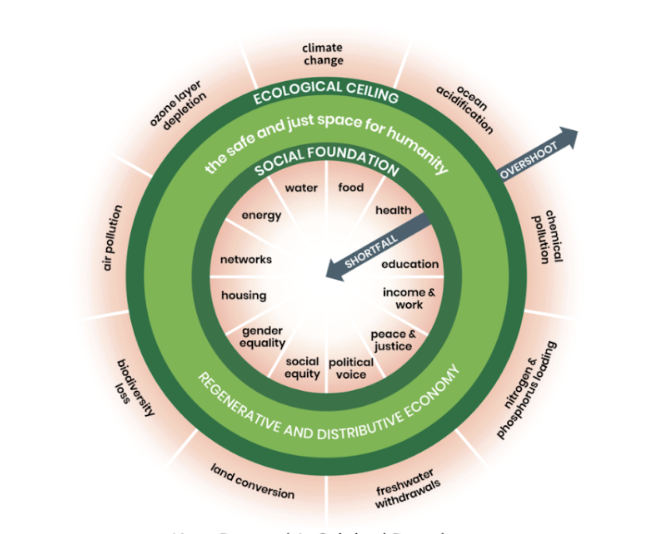Doughnuts Economics in Action
Doughnut Economics and City Portraits worldwide
Doughnut Economics: A Beginner’s Guide
Doughnut Economics offers a vision and new economic model for what it means for humanity and the planet to thrive in the 21st century.
Developed by Oxford economist Kate Raworth in her book Doughnut Economics: Seven Ways to Think Like a 21st-Century Economist, the framework proposes an economic mindset that reorients us away from continuous economic growth and GDP as the main measures of prosperity. Instead, it suggests that in order to meet the needs of all people, within the means of the planet, we need a holistic measure of wellbeing that considers what it looks like for people to thrive in balance with nature.
The Doughnut includes two concentric rings representing the social and ecological boundaries of an economy that is in service to people and the planet:

The inside edge of the Doughnut, the Social Foundation, represents the minimum standards necessary for human wellbeing. It includes essentials such as clean water, food, housing, and peace and justice, as defined and agreed internationally through the United Nations Sustainable Development Goals.
The outside edge of the Doughnut, the Ecological Ceiling, represents the ecological limits of our environment. These include factors such as climate change, biodiversity loss and other environmental concerns that, if overshot globally, could lead to the collapse of Earth’s ecosystems. These are defined based on global climate science, led by theStockholm Resilience Centre, among many others.
Between the two layers is a doughnut-shaped ‘Safe and Just Space for Humanity’ – the ‘sweet spot’ – where human needs are met without overshooting the planet’s ecological limits.
Doughnut Economics also defines ‘Seven ways to think like 21st century economist’, outlining how we can shift from our current economic paradigm towards one that moves us into the future – and indeed, into the present – that we and our planet increasingly require.
For more information:
- Kate Raworth TED Talk on Doughnut Economics (video)
- Doughnut Economics Action Lab - About Doughnut Economics
City Portraits around the world
The City Portrait is a tool to help places - cities, regions and communities - to explore what it means for them to be ‘in the Doughnut,’ in the Safe and Just Space for Humanity.
In 2020, Amsterdam was the first place to to downscale the Doughnut Economics framework and examine the city’s performance socially and ecologically in relation to it. The Amsterdam City Doughnut became known as a City Portrait, and provided direction for new city strategies and policies, such as the Amsterdam Circular Strategy 2020-2025.
Based on international interest in this example, Creating City Portraits: A methodological guide from the Thriving Cities Initiative was developed.
The City Portrait methodology focuses on four ‘lenses’ through which to understand a place:
Local-Social: What would it mean for the people of this city to thrive?
Local-Ecological: What would it mean for this city to thrive within its natural habitat?
Global-Social: What would it mean for this city to respect the wellbeing of people worldwide?
Global-Ecological: What would it mean for this city to respect the health of the whole planet?
Since this time, policymakers, economists and activists globally have adopted and localised this approach to their respective settings. In some places, developing a City Portrait itself has been the focus, but in many places, as in Amsterdam, the City Portrait has been used to gain a baseline understanding of the city to shape policies and practices that prioritise human wellbeing while respecting planetary boundaries.
This has led to a global movement at a local level, supported by Kate Raworth’s team at the Doughnut Economics Action Lab (DEAL). The DEAL team and website host a community of practitioners globally and share resources to facilitate localisation of the Doughnut Economics framework. The City Portrait methodology has evolved to reflect the diversity of approaches taken by cities globally. These include both a quantitative Data Portrait of Place, in which targets and indicators are determined for each social and ecological element in the Doughnut, and a qualitative, more conceptual Community Portrait of Place, where participatory workshops and lived experience reflections create a picture of the hopes and aspirations of people in a place.
The City Portrait for Greater Melbourne draws on the experiences of cities from around the world and the range of tools and approaches that have emerged from them. The community-led research that led to the publication of Towards a Regenerative Melbourne mirrors many aspects of the Community Portrait of Place approach. Building on this, the current City Portrait is heavily quantitative, in keeping with the Data Portrait of Place, but it retains some of the original community-led narrative elements and recognises the value of stories to bring data to life.
In addition, the data in the City Portrait for Greater Melbourne focuses primarily on the Local-Social (Social Foundation) and Global-Ecological (Planetary Boundaries) lenses; the Local-Ecological and Global-Social lenses are currently articulated through description. Future iterations will expand this content to incorporate relevant quantitative measures across all four lenses.